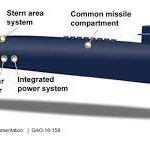How Huge Military Contractors Will Get Even Richer Off The Australian Submarine Deal

Under the cloud of smoke around the Australian submarine deal, are the unspoken aspects of the enrichment of American military contractors. There is no public mention of which American contractors will build the expensive parts of the expensive Australian submarines. Even more significant, there is no public mention of how there used to be, but will not be, debate on the hundreds of billions of dollars for a large fleet of expensive submarines for the United States itself.
However, there is plenty to figure out on these unspoken subjects. I was a Commissioner on the Commission on Wartime Contracting in Iraq and Afghanistan. I have seen military contractors in action. I have learned one must figure things out before they tell us.
First of all, what American contractors will build the parts of the submarine? I assume that the submarines for Australia will be assembled at Australia’s formidable shipyards. Among other reasons, that will buy off the Australias’ own military industry and the associated Australian ministers and legislators. However, the big money is in the parts rather than the assembly. Never is this more so than with today’s nuclear submarine, for which the “parts” include a nuclear reactor and all its associated gear.
As for the American contractors for these pricey parts, the likeliest candidates are those who build the most advanced American nuclear submarine. That submarine is the Columbia-class submarine, designed to replace the Ohio-class United States submarine. The remaining Ohio-class submarines are being decommissioned, one per year, beginning in 2027. Then the Columbia-class will take over. So you see, to make these submarines, including Australia’s, we are talking about commitment to a very long-term and large-scale program involving funds, funds, and more funds.
The cold cash figures for the Columbia class program are hard to believe. The total lifecycle cost of the entire Columbia class is estimated at $347 billion. The cost to build Columbia, the lead boat of the class, will be an estimated $6.2 billions (including planning for the whole class). The Navy has a goal of reducing the average cost of the remaining 11 to a mere $4.9 billion (fiscal 2010 dollars).
The Columbia class is being designed by Electric Boat, a subdivision of General Dynamics GD +0.3%, with help from Newport News Shipbuilding, a subdivision of Huntington Ingalls HII +0.4%. General Dynamics and Huntington Ingalls have the only two shipyards in the United States capable of building nuclear submarines. Huntington’s own shipyards are in Newport News, Virginia, and Pascagoula, Mississippi. The Congressional delegations of both areas will always be staunch supporters, on a bipartisan basis, of costly projects.
They are used to working together. On the Ohio-class submarines, General Dynamics served as the prime contractor and lead design shipyard. General Dynamics would do most of the work, including final assembly. Huntington Ingalls served as the main subcontractor, participating in the design and construction and performing 22 to 23 percent of the required work. Even cutting off a piece for the Australian shipyard, the money for the two American giants will be huge.
However, to understand the full implications for the pandemic-weary American taxpayer, go back just a few years ago. There used to be a quiet, but serious debate about whether or how much to buy into that $347 billion. The nuclear submarine had been seen, since the 1960s, as part of a “strategic triad,” to carry nuclear warheads to deter the other side in the Cold War (or to obliterate them if it came to that). The other two parts of the triad were the strategic bomber, and the intercontinental ballistic missile. These had been aging and there had to be new components for the triad. But, did we really need full numbers of all three? There were arguments for having all three, but given the cost, it was still in debate.
The debate has quieted a little. China’s aggressive military buildup has returned American thinking to old Cold War lines. However, there could still be time to adapt. The number of nuclear submarines can be rationalized, but could be considered at some future time. Who knows what both the China and the United States might do to save money as climate change become really fierce in years to come.
Going back to the source of this piece, Australia’s commitment to the American submarine could be, but, will not be, considered as a way to reduce the number of Columbia-class American submarines. After all, we will be treated to a major multi-national chorus of how, when it comes to submarines facing off China, we stand shoulder to shoulder with submarines. So why not take Australia’s projected numbers and use them for prudent consideration of America’s numbers? If that is not done, maybe it is in part due to the appetites of the huge military contractors.
I am Professor at the University of Baltimore School of Law, where I focus on government contracting and Congressional legislating. I served as Commissioner on the Congressionally-chartered Commission on Wartime Contracting in Iraq and Afghanistan, in which I did three missions to Iraq and Afghanistan, and over 20 televised hearings. My chief published work on government contracting is a leading 750 page legal casebook, Government Contracting Law in the Twenty-First Century. I have testified before Congressional committees as an expert many times about Government contracting, problem departments, and government personnel. I was General Counsel (Acting) of the House of Representatives, serving15 years in that office and its Senate counterpart, and published a 1000 page treatise, Congressional Practice and Procedure. I am publishing with University Press of America a new book, The Polarized Congress: The Post-Traditional Procedure of its Current Struggles. I graduated from Columbia College with a B.A. summa cum laude and from Harvard Law School with a J.D. magna cum laude, and served on the Harvard Law Review.
